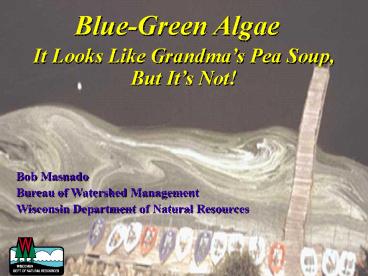Bob Masnado - PowerPoint PPT Presentation
1 / 19
Title:
Bob Masnado
Description:
Scum Layers Common for Buoyant Varieties. Discolored Water. Taste & Odor Problems ... High Risk: Scum Layer Formation in Bathing Areas. Beach Advisories/Closures: ... – PowerPoint PPT presentation
Number of Views:55
Avg rating:3.0/5.0
Title: Bob Masnado
1
Blue-Green Algae
It Looks Like Grandmas Pea Soup, But Its Not!
Bob Masnado Bureau of Watershed
Management Wisconsin Department of Natural
Resources
Bob Masnado Wisconsin Department of Natural
Resources Bureau of Watershed Management
2
Presentation Overview
- Blue-Green Algae
- What is it?
- What are algae blooms?
- What are algal toxins?
- What is being done to study blue-green algae?
- What can be done to control blue-green algae?
Photo by Wisconsin Department of Natural
Resources
3
Blue Green-Algae
- Single-Celled Organisms aka Cyanobacteria
- Very Common in Freshwater Lakes
- Possibly First Organisms to Conduct
Photosynthesis - Important Nitrogen Fixers
4
Blue Green-Algae
- Frequently Bloom to Nuisance Levels in
Nutrient-Enriched Water
- Three Very Common Species in Wisconsin Waters
- Annie, Fannie, Mike
- Anabaena sp.
- Aphanizomenon sp.
- Microcystis sp.
Photo Courtesy of Vermont Department of Health
Photo Courtesy of Maryland DNR
5
Blue-Green Algae Blooms
- Generally Occur in Summer Months
- Temperature Warm/Hot
- Nutrients Highly Enriched w/
- Phosphorus and Nitrogen
- Photoperiod Lots of Sunlight
- Weather Patterns Calm Periods w/ Low Turbulence
(e.g., dog days of summer)
Photo by Wisconsin Department of Natural
Resources
6
Blue-Green Algae Blooms
- Bloom-Related Problems
- Scum Layers Common for Buoyant Varieties
- Discolored Water
- Taste Odor Problems
- Reduced Light Penetration for
- Important Plant Species
- Dissolved Oxygen Depletions During Die-Off
- Possible Release of Toxins During Die-Off
- Potential Health Problems to Animals Humans
Photo Courtesy of Minnesota Pollution Control
Agency
7
Blue-Green Algal Toxins
- Some Species Produce One or More Intra-Cellular
Chemicals Called Algal Toxins - Naturally Occurring - Not Introduced or Created
By Humans - Contained within Living Cells
- Toxin Production Normally Not Continuous (Varies
with Algal Strain Environmental Factors) - Released to Water Column Upon Cell Death
8
Blue-Green Algal Toxins
- Endotoxins Skin irritation, gastro-intestinal
problems (e.g., cause stomach cramps, nausea,
etc.)
- Neurotoxins Interfere w/ Central Nervous System
- Anatoxin-a
- Saxitoxin
- Hepatotoxins Interfere w/ Liver Kidney
Function - Microcystin
- Cylindrospermopsin
9
Blue-Green Algal Toxins
- Animal Exposure Routes
- Direct Ingestion of Pond/Lake Water
- Immersion
- Human Exposure Routes
- Recreation (e.g., swimming, boating, etc.)
- Municipal Drinking Water Supplies
10
Blue-Green Algal Toxins
- Animal Poisonings
- Deaths reported worldwide for cattle, swine,
sheep, dogs, etc. - Suspected in American Alligator die-offs in
Florida.
- Human Poisonings
- Palm Island, Australia (1979) Cylindrospermopsin
- Caruaru, Brazil (1996) Microcystin
- Madison, Wisconsin (2002) Anatoxin-a
11
Recreational Water Guidance
- World Health Organization Guidance for Blue-Green
Algae - Low Risk 20,000 - 100,000 cells/ml
- Moderate Risk 100,000 cells/ml
- High Risk Scum Layer Formation in Bathing Areas
- Beach Advisories/Closures
- Responsibility is Shared by County/Local Health
Departments In Consultation with Department of
Health Family Services
12
Current WDNR Studies
- Study Period July - September 2004
- Goals
- Blue-Green Presence/Absence in 30 Eutrophic
Lakes Throughout Wisconsin - Blue-Green Presence/Absence in Area Ponds (e.g.,
Natural, Stormwater Detention, Golf Course) - Algae Enumeration Where Densities are Elevated
- Toxin Presence/Absence Where Densities are Very
High
13
Preliminary Findings
Presence/Absence
14
Preliminary Findings
Cell Enumeration
World Health Organization Threshold of
100,000 cells/mL
15
Preliminary Findings
Algal Toxin Analyses (n 28)
- Anatoxin-a was detected in one sample.
- (1.5 µg/L, Colladay Point Pond - July 30th)
- Cylindrospermopsin was not detected in any
samples. - Microcystin was detected in 19 samples.
- (Range from 1.4 µg/L - 7,600 µg/L)
16
What Can You Do To Reduce Personal Exposure?
- Use Common Sense
- Do not drink untreated water from natural water
bodies regardless of whether noticeable algae
blooms are present. - Do not let children, livestock, or pets get into
or drink water where algae are readily visible. - Do not wade or swim where algae are readily
visible. - Shower or rinse off after swimming or recreating
in natural water. - If you or someone you were with becomes ill after
swimming or recreating on the water, contact your
local health department and your personal
physician.
17
What Can You Do To Reduce Blue-Green Blooms?
- Play an ACTIVE Role in Nutrient Reduction
- Use lawn fertilizers ONLY when absolutely
necessary and use no more than recommended on
label instructions. - Keep fertilizer out of storm drains and off
driveways and sidewalks. - Maintain or plant native plants around shorelines
and streams. Native plants don't require
fertilizers and help filter water. - Properly care for and maintain your septic
system. - Do not feed waterfowl or allow livestock or pets
to defecate in streams or lakes. - Take steps to prevent soil erosion.
18
Role of Local Water Quality Managers
- Zoning Administrators Should Maintain Appropriate
Riparian Buffers to Minimize Nutrient Loadings. - Community Leaders Should Strive to Increase
Public Awareness of Linkage Between Stormwater
and Water Quality of Nearby Lakes Streams. - Use of Algaecides Should Be Conducted In
Accordance with Appropriate State Federal
Regulations. - Communities w/ Surface Water-Based Drinking Water
Supplies Must Maintain Effective Treatment Plants.
19
Contacts
- For More Information, Please Contact
- Local Health Department Staff
- Wisconsin Department of Natural Resources
- Bob Masnado
- E-mail masnar_at_dnr.state.wi.us
- or
- Dr. Elisabeth Harrahy
- E-mail harrae_at_dnr.state.wi.us




















![❤[PDF]⚡ Bob Ross: Happy Little Puzzles (RP Minis) PowerPoint PPT Presentation](https://s3.amazonaws.com/images.powershow.com/10059737.th0.jpg?_=20240619118)




![[PDF READ] Free Me, Myself, & Bob: A True Story About Dreams, God, and PowerPoint PPT Presentation](https://s3.amazonaws.com/images.powershow.com/10077308.th0.jpg?_=20240712026)

![get⚡[PDF]❤ Bob Ross' Happy Little Night Before Christmas PowerPoint PPT Presentation](https://s3.amazonaws.com/images.powershow.com/10082483.th0.jpg?_=20240720126)

![Download [PDF] Bob and Ray: Keener Than Most Persons (Applau PowerPoint PPT Presentation](https://s3.amazonaws.com/images.powershow.com/10091220.th0.jpg?_=20240802087)

